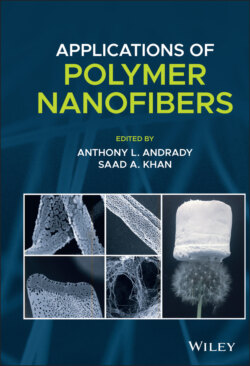Читать книгу Applications of Polymer Nanofibers - Группа авторов - Страница 30
1.7.2 Needleless or “Free‐Surface” Electrospinning
ОглавлениеAlternatively, multijet electrospinning can be achieved by free surface electrospinning or “needleless electrospinning” (Niu et al. 2011; Guo et al. 2010). In needleless electrospinning, an electric field is applied to a thin layer of polymeric solution in the presence as a field concentrator (e.g. cleft made from metal, rotating cylinder) forming a liquid jet. Similar to conventional electrospinning, the jet whips as the polymer solution travels to the collector. When there is sufficient electric field strength, several jets of polymer solution eject from the liquid surface. This jetting from a planar surface typically requires high electric field strength which results in corona discharge in the air impeding the process. To overcome this challenge, perturbations are often introduced to the liquid surface. When an electric field is applied, each bump concentrates charge accumulation on the surface of the polymer solution and becomes the origin of an electrospun jet. Throughput using various needleless setups has been on the order of ~5 g/h. This approach has been commercialized by El Marco. The production rate of the Nanospider™ (El Marco) is at least ~100 g/h (Persano et al. 2013; Niu et al. 2011; Guo et al. 2010).
Comparing traditional needle electrospinning with needleless electrospinning with a model PEO system, the fiber diameters were comparable (Thoppey et al. 2012). Further, nanofiber sizes from needleless electrospinning follow similar trends with processing parameters. Fiber size is proportional to polymer concentration and inversely proportional to collection distance. Examining the applied voltage, the average fiber diameter decreases and fiber size distribution increases with increasing voltage (Han et al. 2014; Nurwaha and Wang 2015). The number of jets increase as the applied voltage increases. The flow rate per jet (i.e. the jet diameter) also increases with increasing voltage. The geometry of the charged electrode affects the electric field and thus also can significantly affect fiber diameter (Han et al. 2014; Nurwaha and Wang 2015). Solution properties also affects the needleless electrospinning process. Adding a significant amount of salt to the polymer solution can decrease the jet diameter. Decreasing the solution viscosity increases the number of jets by minimizing jet‐to‐jet interactions. Decreasing the surface tension maximizes the number of jets to provide the highest throughput (Thoppey et al. 2012). These results qualitatively match modeling approaches to predict the maximum density of jets using a leaky dielectric model, static cone‐jet. Assuming the electric field is balanced by surface tension, the wavelength (λ) with the shortest formation time is
(1.12)
where γ is surface tension, ε 0 is the permittivity of free space, E 0 is the electric field at the edge of the fluid, and is the electric field gradient. The shorter the wavelength, the higher the maximum number of jets. Therefore, the maximum number of jets increases with decreasing surface tension and increasing electric field strength. Additionally, the same relationship for current in needleless electrospinning has been reported (Yener et al. 2013). Counting the number of jets, Yener et al. surmised that the value of current is approximately the same in all the jets occurring simultaneously.
